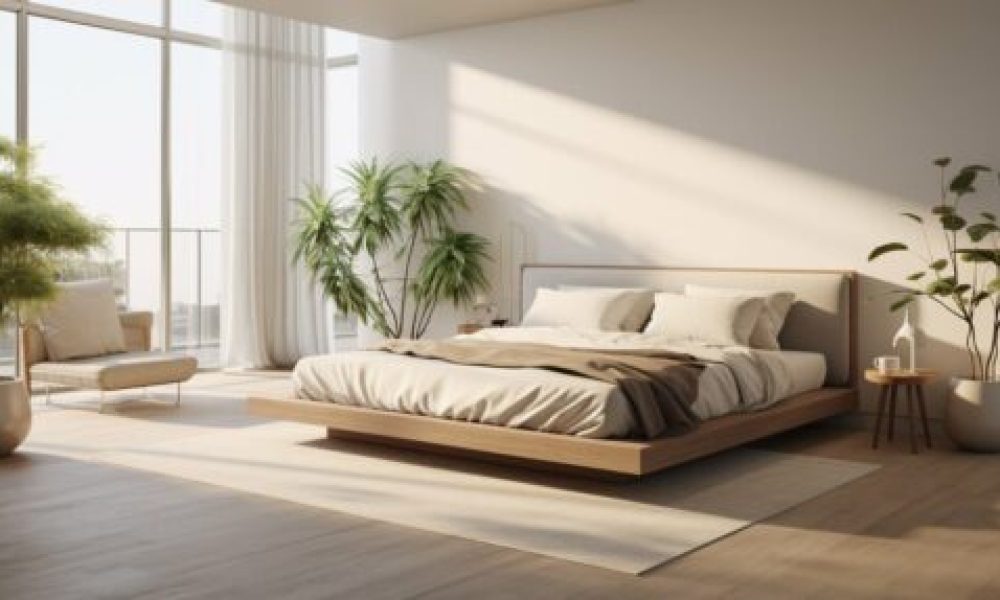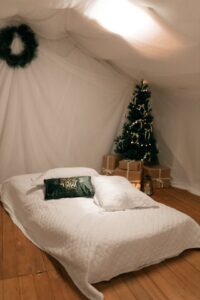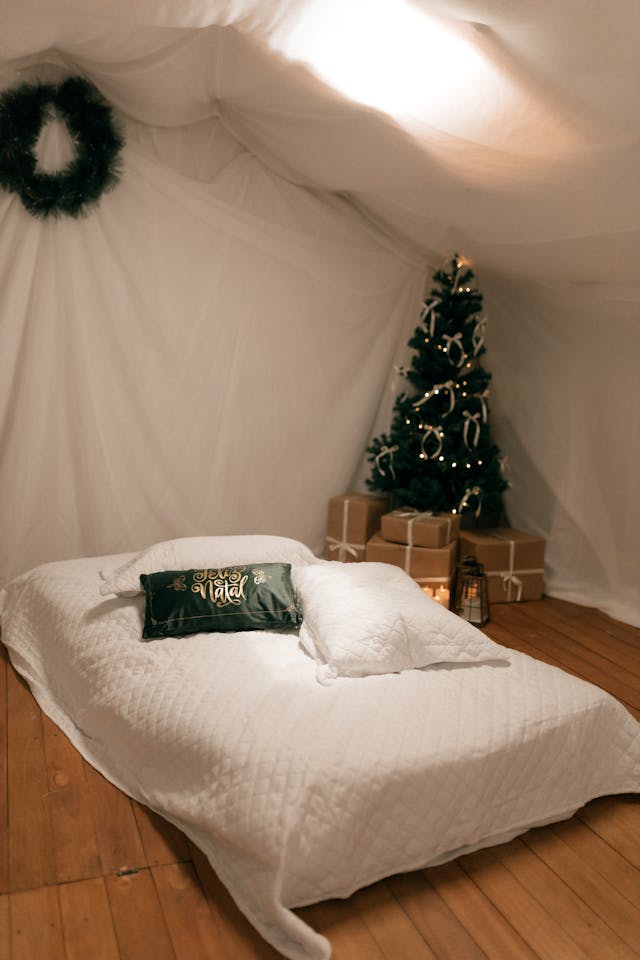Bed Positioning in Feng Shui
Bed positioning in Feng Shui sets the tone for how safe, restored, and connected you feel in your bedroom.
By placing your bed in a supportive spot—especially the commanding position—you improve the flow of chi, reduce restlessness, and create a space that supports healthier relationships.
Key Takeaways: Bed Positioning in Feng Shui
- Use the commanding position: See the door without being directly in line with it.
- Create balance: Leave space and use symmetry for harmony, especially for couples.
- Avoid draining spots: Keep feet from pointing at the door and skip beams overhead.
- Fix tough layouts: Use headboards, rugs, or screens to soften energy flow.
- Mirror wisely: Reflect calming elements, never the bed itself.

Why Bed Positioning Matters in Feng Shui
Your bed is where you spend a third of your life. In Feng Shui, it’s the center of your energy. A supportive layout helps your body feel safe while encouraging steady chi.
When your bed is well-placed, you fall asleep faster, wake less often, and feel more grounded each day. The Sleep Foundation confirms that calming, uncluttered bedrooms improve sleep quality. Explore their tips on bedroom environment and sleep hygiene.

The Commanding Position: Your Bed’s Most Supportive Spot
Answer first:
The commanding position means you can see the door while lying in bed without being in line with it. This setup helps your nervous system relax by creating a sense of safety and awareness.
How to achieve it
Place the bed diagonally across from the door with a solid wall behind the headboard. If that isn’t possible, add a sturdy headboard and a grounding rug. Use a mirror angled to reflect the door, but never point it directly at the bed. For full guidance, see
Feng Shui principles for bedroom layout.

Creating Balance: Space on Both Sides
Answer first:
Leave space on both sides of the bed—ideally 18 inches or more. Add matching nightstands and lamps to create stability and equality.
Design details
Keep pathways open so the bed is easy to access. If one side is tight, use balanced lighting or art to visually expand the space.
For more tips, see the Sleep Foundation’s guide to bedroom environment essentials.
What to Avoid: Common Bed Placement Mistakes
The “coffin position”
Avoid placing your feet directly toward the door.
This is thought to drain energy and can feel unsettling.
If you can’t move the bed, place a bench or chest at the foot as a subtle barrier.
Under beams or sloped ceilings
Heavy beams or steep ceilings create pressure.
If you can’t move the bed, soften the effect with fabric canopies or ceiling treatments.
Backed by plumbing walls
Beds against noisy bathroom walls can disturb sleep. Use a padded headboard, upholstered panel, or a thick rug to buffer sound and energy.
For layout solutions, see Feng Shui bedroom elements. 
Mirrors and Energy: Helpful, with Boundaries
Answer first:
Mirrors expand light and space, but a mirror facing the bed can disturb rest. Instead, angle mirrors to reflect plants, art, or soft daylight.
Where mirrors work best
Place a mirror near the entry or above a dresser to spread light. If you need to see the door from bed, angle the mirror so it reflects a calm focal point. See Better Homes & Gardens advice on bed direction tips.

Style Meets Sleep: Bedding Choices
Answer first:
Bedding materials shape your comfort, temperature, and energy. Natural fabrics and calming colors align with Feng Shui goals.
Eco-friendly vs. conventional
- Organic bedding: Cotton, linen, and lyocell breathe well and last long. They are eco-friendly and gentle on skin.
- Conventional bedding: Often cheaper, but may trap heat or include chemical finishes that affect comfort.
See our guide to temperature-regulating bedding and organic bedding for details.
Color, Clutter, and Calming Details
Answer first:
Soft colors and tidy surfaces create peace. Greens, blues, and neutrals are especially restful.
Practical fine-tuning
Keep nightstands simple with just a lamp, water, and maybe a plant.
Limit electronics and charge devices outside the room.
For design ideas, see Parachute Home’s take on Feng Shui interior design.

Quick Buyer’s Guide: Headboards, Rugs, Nightstands
Answer first:
Solid headboards, grounding rugs, and balanced nightstands anchor the bed.
They stabilize energy and add comfort.
- Headboard: Pick a solid design for support. Avoid open slats.
- Rug: Extend an area rug beyond the bed for warmth and quiet.
- Nightstands: Keep scale even on both sides.
For healthy nighttime habits, see
Sleep Foundation tips.
FAQ
- What is the best bed positioning in Feng Shui?
- The commanding position—see the door without being in line with it—creates safety and calm.
- Why avoid mirrors facing the bed?
- Mirrors reflecting the bed can disturb rest. Angle them toward calming objects instead.
- Can I fix bad bed positioning without moving the bed?
- Yes. Add a solid headboard, place a rug, or use a bench at the foot for balance.
- How do bedding materials affect Feng Shui?
- Natural, breathable fabrics improve comfort and reinforce restful energy in the bedroom.
Final Thoughts
Thoughtful bed positioning in Feng Shui turns your bedroom into a peaceful retreat.
Use the commanding position, keep balance, and fix problem spots with simple tools.
Explore Cozy Bed Quarters guides on
Feng Shui principles,
bedroom elements, and
temperature-regulating bedding.
Related Reading
- Feng Shui Principles for Bedroom Layout
- Feng Shui Bedroom Elements: Invite Calm and Balance
- Organic Bedding: 5 Reasons You’ll Love the Switch
- Sleep Foundation: Bedroom Environment
- Better Homes & Gardens: Bedroom Layout Mistakes
- Parachute Home: Feng Shui Interior Design























